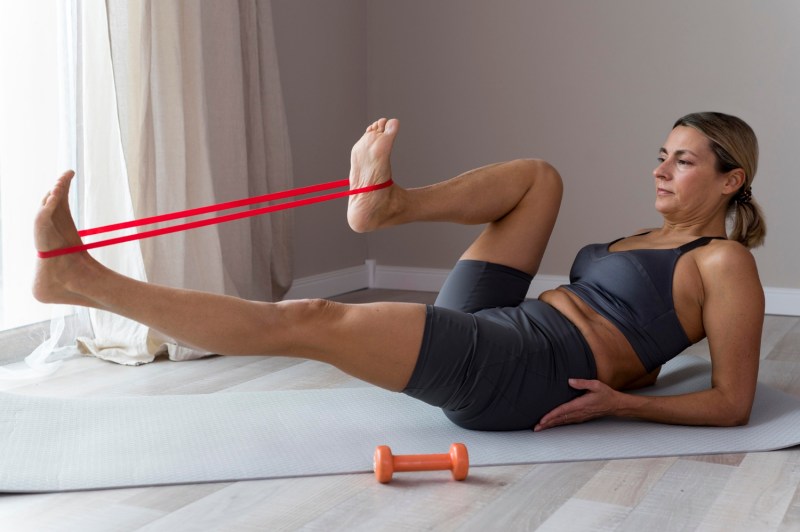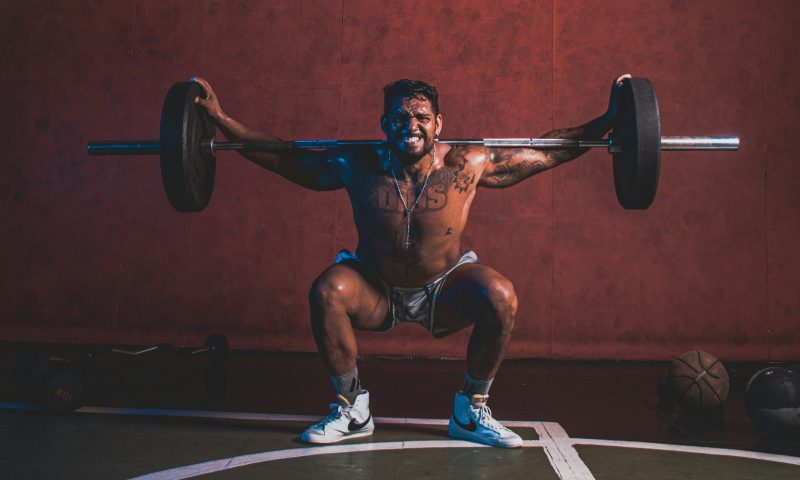Are you looking to develop a stronger core but only have access to resistance bands? No problem! Luckily, resistance bands are a versatile piece of equipment that can add resistance to simple ab exercises to help strengthen and define. As a personal trainer, I frequently recommend resistance bands for clients who are traveling or exercise at home.
A consistent routine could result in the abs of your dreams, so keep reading to discover seven ab exercises with resistance bands to include in your workout rotation!
7 resistance band ab exercises you can do anywhere

These resistance band ab exercises require minimal space and equipment but deliver maximum core engagement. Add them to your routine for stronger, more defined abs—no gym needed.
1. Banded bicycle crunches
Instructions:
- Loop the band around both of your feet.
- Lie on your back with your hands behind your head and knees bent.
- Extend one leg while bringing the opposite elbow toward the bent knee.
- Alternate sides with control.
Recommended sets and reps: 3 sets of 12–15 reps per side
2. Resistance band plank pulls
Instructions:
- Anchor the band in front of you, low to the ground.
- Get into a forearm plank and grab the band with one hand.
- Pull the band toward your body in the same motion as a lat pulldown before extending your arm again.
- Switch arms after each set.
Recommended sets and reps: 3 sets of 10 reps per arm
3. Seated Russian twists
Instructions:
- Sit with your knees bent and feet hovering an inch off the floor.
- Anchor the band on one side, and hold the band taut between your hands.
- Twist your torso to the opposing side, keeping the band under tension.
- After completing one set, flip your body around and work the other side.
Recommended sets and reps: 3 sets of 20 reps (10 per side)
4. Banded dead bugs
Instructions:
- Lie on your back, and loop the band around both of your feet.
- Raise your arms straight above you, in line with your shoulders. Bring your legs up and have your knees at a 90-degree angle.
- Extend one leg while the opposite arm reaches overhead.
- Return to the starting position, and switch sides.
Recommended sets and reps: 3 sets of 10 reps per side
5. Standing oblique crunch
Instructions:
- Anchor a band under one foot and hold the other end overhead.
- Crunch your torso sideways, engaging your obliques.
- Return slowly to the starting position before repeating.
- Switch sides after each set.
Recommended sets and reps: 3 sets of 12–15 reps per side
6. Banded reverse crunches
Instructions:
- Secure the band to an anchor at floor level.
- Lie on your back and loop the band around your feet. Make sure you are far enough from the anchor that the band is slightly taut.
- Pull your knees toward your chest, going against the resistance of the band.
- Lift your hips off the floor, then lower with control.
Recommended sets and reps: 3 sets of 15 reps
7. Banded woodchoppers
Instructions:
- Anchor the band at a point above your head and stand with your feet shoulder-width apart.
- Hold the band with both hands.
- Pull it diagonally across and down your body, rotating your torso.
- Return your arms to the starting position, then switch sides after completing the predetermined number of reps.
Recommended sets and reps: 3 sets of 10–12 reps per side
Can you get abs with only a resistance band?

Yes, you can develop strong abs using only a resistance band—as long as you’re consistent, gradually increase intensity, and maintain a healthy lifestyle. Resistance bands are highly effective for core training and can offer similar benefits to traditional gym equipment.
One study on sedentary adults found that “The results for the [Elastic Band Group] show a decrease in fat mass and an increase in both the fat-free mass and the number of repetitions [performed in the knee push-up] and [squat] tests.” These results suggest that elastic resistance can contribute to better muscle definition and improved body composition, both of which support visible abs.
Another study examining male athletes using resistance bands noted that “The results suggested a statistically significant improvement in control group for upper & lower abdominal strength, power and balance of the upper extremity.” This highlights the ability of bands to effectively target the core through functional movement.
Something important to note is that while resistance bands can build ab muscles, seeing those abs still depends on reducing overall body fat through diet and regular cardio.
How often should you train your abs for results?

For visible and strong abs, aim to train your core two to four times per week. Your abdominal muscles, like any other muscle group, need time to recover between sessions—especially if you’re using resistance. Focus on quality over quantity by incorporating progressive overload, such as adding resistance bands or increasing reps. Core workouts can be short, around 10 to 15 minutes, but consistency matters most. Avoid training abs every single day, as overworking them can lead to fatigue and reduced performance. As we mentioned before, you also want to pair your training with proper nutrition and strength and cardio workouts for the best results.
Other tips for achieving a strong, defined core

- Focus on compound movements like squats and deadlifts, which naturally engage the core muscles during each rep.
- Maintain good posture throughout the day to keep your core activated and reduce lower back strain.
- Incorporate a mix of stability, strength, and rotational exercises to target all areas of the core, including the obliques and transverse abdominis.
- Stay consistent with your workouts and gradually increase intensity or resistance to keep making progress.
- Prioritize proper form to avoid injury and ensure you’re targeting the correct muscles.
- Combine core training with full-body strength training and cardio to reduce overall body fat.
- Get adequate sleep each night, as recovery and hormone balance play a role in muscle development.
- Stay hydrated and follow a balanced diet rich in whole foods to support energy levels and lean muscle growth.
Frequently asked questions

What is the most effective abs workout?
The most effective abs workout targets all areas of the core—upper, lower, and obliques—using exercises like planks, bicycle crunches, hanging leg raises, and ab rollouts. Adding resistance, such as resistance bands or cables, increases intensity.
Do resistance bands help with belly fat?
Resistance bands help build muscle and burn calories, which supports overall fat loss—including in your belly. While you can’t spot-reduce fat, using bands in strength workouts boosts metabolism and improves muscle tone. Combined with a healthy diet and regular cardio, resistance bands can be an effective tool for slimming your waistline.
Can I get ripped with resistance bands?
Yes, you can get ripped with resistance bands by training consistently and progressively challenging your muscles. Bands can build strength, definition, and core stability. When paired with a clean diet, they’re effective for developing visible abs and a lean physique. The key is intensity, variety, and disciplined effort over time.




